Year in Review: Deep Learning Papers in 2023
January 27, 2024 | 12 min read
As we step into 2024, let’s take a moment to look back at the significant progress made in deep learning throughout the past year. In this year-in-review post, I’ll share my 10 favorite papers from 2023. I hope you enjoy it!
If you’re interested in this post, you can also check out my review of the previous year, 2022.
Fast Inference from Transformers via Speculative Decoding
- Authors: Yaniv Leviathan, Matan Kalman, Yossi Matias
- Paper: https://arxiv.org/abs/2211.17192
- Venue: ICML 2023
In LLM-powered applications such as chatbots, it’s autoregressive decoding that limits the latency of the application. If you want to generate tokens, you need to run the inference times. This is slow. What can we do to make it faster without degrading the output quality?
Speculative decoding is a technique that allows autoregressive models to run faster without changing the outputs. The idea is to have a smaller (faster but less performant) language model that samples chunks of tokens quickly, and then the larger LM examines each of them to accept or reject. In the image below, each line represents one iteration, where the smaller LM samples tokens (green) and the larger one rejects (red) and makes corrections (blue).

This is quite intuitive when you think that the difficulty of language modeling is not always the same. Sometimes it is very easy (what 3 tokens come after “Tokyo is the capital…?”) and sometimes it is very ambiguous (you don’t know what comes after “My favorite food is…”).
Once we have a chunk of tokens (,…,), we calculate the set of likelihoods ,…, with the larger LM in parallel (no more sequential inference from the large model!). Then we check the likelihood one by one to reject unlikely tokens. Specifically, for each token, we sample a threadshold from the uniform distribution , and if the likelihood computed the large model () is high enough compared to that by the small model (), that is, if , we accept the token and look at the next one. Otherwise, we reject the token and the following ones. This way, we can sample tokens up to 3 times faster and still ensure the same output quality. See the figure below to get a sense of why speculative decoding is fast.

Adding Conditional Control to Text-to-Image Diffusion Models
- Authors: Lvmin Zhang, Anyi Rao, Maneesh Agrawala
- Paper: https://arxiv.org/abs/2302.05543
- Code: https://github.com/lllyasviel/ControlNet
- Venue: ICCV 2023
As I wrote in the last year’s review, we saw many cool text-to-image (T2I) models in 2022. But they struggled to provide control over the spatial composition of the image because fully expressing layouts, poses, and shapes with words is not easy. Sometimes, we want to give image-based instructions to generate our desired outputs. For example, we might want to use edge maps, human pose skeletons, segmentation maps, and depth maps. For example, we might use edge maps, human pose skeletons, segmentation maps, and depth maps. However, there was no model capable of taking any type of those image inputs and generating images based on it.
ControlNet enables pre-trained T2I diffusion models, such as Stable Diffusion, to follow instructions in images. Look at the figure below to see how ControlNet-powered Stable Diffusion can generate images that are loyal to the input Canny edge and human pose.
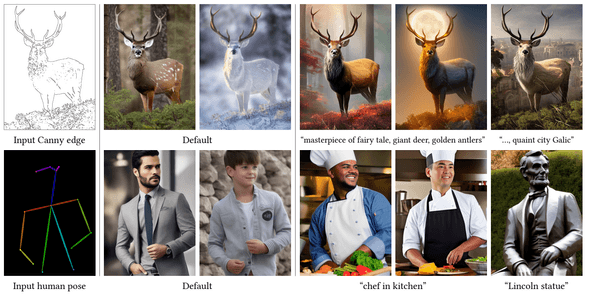
You can train ControlNet with relatively small compute resources. It freezes the pre-trained weights of Stable Diffusion and uses adapters in the U-net decoder blocks to incorporate information from the image condition into the generated image. Each adapter consists of trainable copies of U-net encoder blocks and convolution layers with weights initialized to zero (zero convolution). See the figure below for more details.
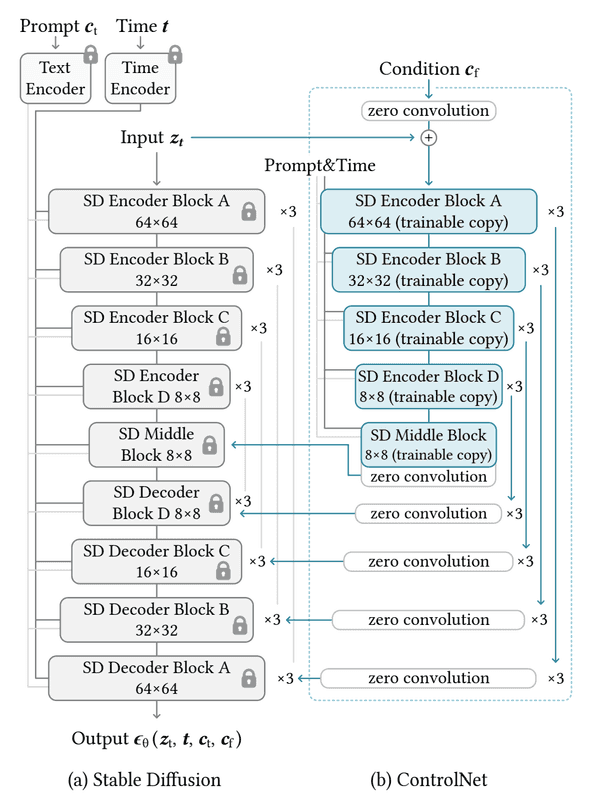
Sigmoid Loss for Language Image Pre-Training
- Authors: Xiaohua Zhai, Basil Mustafa, Alexander Kolesnikov, Lucas Beyer
- Paper: https://arxiv.org/abs/2303.15343
- Venue: ICCV 2023
CLIP revolutionized how we train image models by introducing the idea of contrastive learning with massive pairs of images and captions. I discussed how CLIP was innovative in my Year in Review for 2021. But training CLIP, even fine-tuning it, is not straightforward. Since CLIP relies on softmax loss from all possible pairs between images and captions available in the batch, it necessitates using as large a batch size as possible to succeed in training. For example, this version of CLIP was trained with a batch size of 160k 🤯.
Good news! SigLIP (sigmoid loss for language-image pre-training) saves GPU-poors. The algorithm of SigLIP is as simple as this:
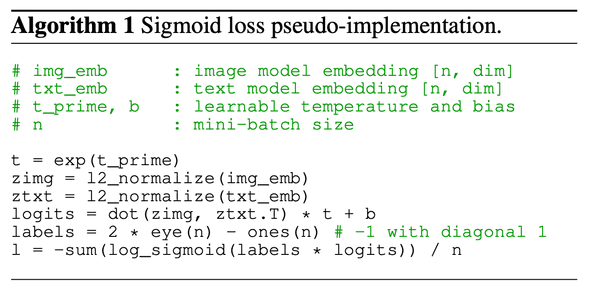
It essentially replaces the softmax loss with a sigmoid loss, eliminating the need to compute global normalization factors. It introduces a new hyperparamter to learn faster from the loss dominated by many negatives, but it’s not a big change.
SigLIP achieves higher accuracy in downstream tasks than its softmax counterpart when trained with smaller batch sizes. The authors also found that the performance gain diminishes when the batch size grows to ~32k.

Segment Anything
- Authors: Alexander Kirillov, Eric Mintun, Nikhila Ravi, Hanzi Mao, Chloe Rolland, Laura Gustafson, Tete Xiao, Spencer Whitehead, Alexander C. Berg, Wan-Yen Lo, Piotr Dollár, Ross Girshick
- Paper: https://arxiv.org/abs/2304.02643
- Project page: https://segment-anything.com/
- Code: https://github.com/facebookresearch/segment-anything
- Blog: https://ai.meta.com/blog/segment-anything-foundation-model-image-segmentation/
- Venue: ICCV 2023
CLIP was the first single model capable of handling any image-wise tasks (e.g., open-ended classification, image retrieval). Then, could there be a single model for any pixel-wise tasks (e.g., semantic segmentation, instance segmentation)? Yes. Segment Anything Model (SAM) is the first such model. This is a big deal because training pixel-wise model is time-consuming work, requiring a lot of pixel-wise annotations. With SAM, you can do any pixel-wise task with prompting.
How does SAM work? First, the authors framed the problem as promptable segmentation, where the goal is to return a valid segmentation mask given any segmentation prompt. Here, a prompt can be text or an image that shows the region of interest through a bounding box, scribble, or points.

To process an image and a prompt, SAM has two encoders. The image encoder is heavyweight and outputs embeddings. The prompt encoders are lightweight, and their embeddings are fed into the mask decoder along with the image embeddings. To tackle the inherent ambiguity in the prompts, the decoder outputs multiple valid masks and associated confidence scores.

For training SAM, the authors created a dataset called SA-1B. To creating this dataset, they developed a machine learning-based pipeline that automatically generates high-quality annotations. This is a crucial step because obtaining pixel-wise annotations for 1 billion images is not straightforward. They released the dataset SA-1B as well as the model. See the project page for more details.
Are Emergent Abilities of Large Language Models a Mirage?
- Authors: Rylan Schaeffer, Brando Miranda, Sanmi Koyejo
- Paper: https://arxiv.org/abs/2304.15004
- Venue: NeurIPS 2023
Let me start with a quick question: do you remember the figure below?

This figure was viral in 2022 and went outside of the research community, often accompanied by exaggerated interpretations like “GPT-4 is even bigger than GPT-3. AGI is coming. The world is over”. But we know GPT-4 is not “emergent” in such a dramatic sense. So, what was misleading about the figure, or the doomsayers’ interpretations?
If you have trained a classification model with gradient descent, you probably understand how different metrics can present different narratives. Your loss function (e.g., cross-entropy) steadily decreases, while your accuracy might remain stagnant for a while before suddenly increasing. This phenomenon occurs because accuracy is a discrete function of the model’s output, and a noticeable difference in the predicted category requires the model’s output to cross a certain threshold.
The same principle likely applies to the figure mentioned above. Look at the vertical axes: they are accuracy, exact match, and BLEU score, all of which are discrete functions (recall your exams – nobody likes exact matches). The authors of “Are Emergent Abilities of Large Language Models a Mirage?” tested this hypothesis by changing the metrics. They showed that “emergent behaviors” could be induced or mitigated by selecting specific metrics.
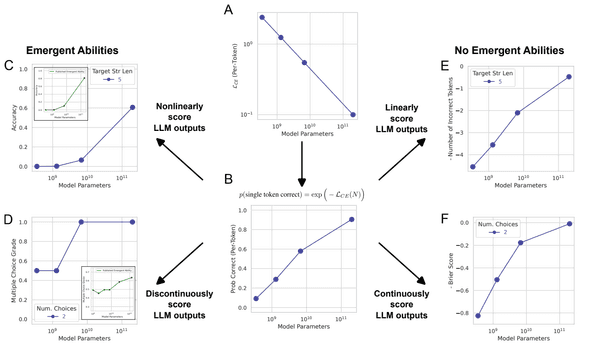
Direct Preference Optimization: Your Language Model is Secretly a Reward Model
- Authors: Rafael Rafailov, Archit Sharma, Eric Mitchell, Stefano Ermon, Christopher D. Manning, Chelsea Finn
- Paper: https://arxiv.org/abs/2305.18290
- Venue: NeurIPS 2023
One of the key ingredients of successful LLMs is reinforcement learning from human feedback (RLHF). It enables LLMs to align with human values by learning from a reward model that simulates human preferences. However, RLHF is complex, unstable, and computationally expensive, posing a significant barrier to LLM alignment.
Direct preference optimization (DPO) emerges as a new fine-tuning method that allows LLMs to align with human preferences without the need for reinforcement learning. The authors have derived an optimal policy that satisfies human preferences in closed form, enabling DPO to rely on a simple classification loss instead of a complex reward model. This makes DPO more stable, lightweight, and computationally efficient compared to RLHF.

DPO has proven effective not only in theory but also in practice. Being tested up to 6B parameter models, it demonstrates a better trade-off between reward and discrepancy from the original policy (as shown in the left panel in the figure below, where RLHF is labeled as “PPO”). Furthermore, DPO was adopted to train the successful Mixtral 8x7B model.
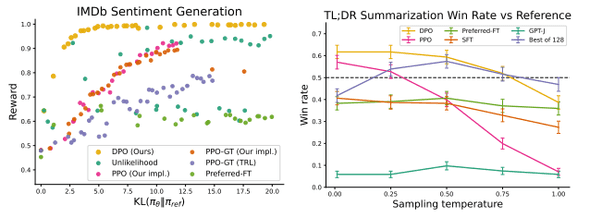
3D Gaussian Splatting for Real-Time Radiance Field Rendering
- Authors: Bernhard Kerbl, Georgios Kopanas, Thomas Leimkühler, George Drettakis
- Paper: https://arxiv.org/abs/2308.04079
- Project page: https://repo-sam.inria.fr/fungraph/3d-gaussian-splatting/
- Code: https://github.com/graphdeco-inria/gaussian-splatting
- Venue: SIGGRAPH 2023
When it comes to 3D scene reconstruction and rendering, neural radiance field (NeRF) methods have been the state-of-the-art. Since its debut in 2020, NeRF has been drawing more and more attention. I chose Block-NeRF as one of the most exciting papers in 2022.
However, in 2023, we witnessed the advent of a new method called 3D Gaussian Splatting. As the name suggests, this technique represents a scene using a set of 3D Gaussians. It begins by initializing Gaussians from a sparse Structure-from-Motion (SfM) point cloud and then iteratively optimizes its parameters (shape and density) by minimizing the discrepancy between rasterized images and the ground truth.

3D Gaussian Splatting allows real-time rendering (>30 FPS) at the highest quality while maintaining competitive training times. The figure below offers a glimpse of its superiority, but I also recommend visiting the project page for more visualizations.

Vision Transformers Need Registers
- Authors: Timothée Darcet, Maxime Oquab, Julien Mairal, Piotr Bojanowski
- Paper: https://arxiv.org/abs/2309.16588
- Venue: ICLR 2024
Did you know that pretrained Vision Transformers (ViTs) have artifacts in their attention maps? The figure below demonstrates that ViTs trained with different strategies (label supervision for DeiT, text supervision for CLIP, and self-supervision for DINO) exhibit similar artifacts in the background.
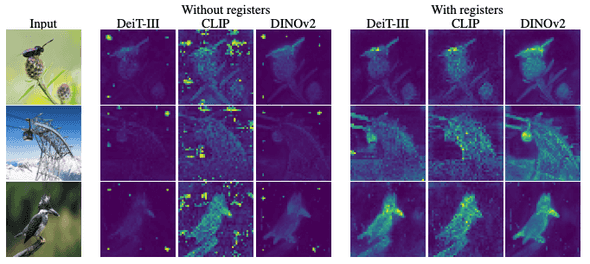
The authors of this paper identified this phenomenon and attributed it to the high-norm tokens in the background. They also discovered that these tokens tend to appear as the model scales in size and training duration, and that they carry global information rather than local information. These insights inspired them to propose a simple yet effective solution: adding register tokens [REG] to the input sequence.

This solution has proven effective across different ViTs, and the repository for DINOv2 has already adopted it.
Open X-Embodiment: Robotic Learning Datasets and RT-X Models
- Authors: Open X-Embodiment Collaboration
- Paper: https://arxiv.org/abs/2310.08864
- Project page: https://robotics-transformer-x.github.io/
- Code: https://github.com/google-deepmind/open_x_embodiment
- Blog: https://www.deepmind.com/blog/scaling-up-learning-across-many-different-robot-types
- Venue: CoRL 2023 Workshop
Foundation models changed the way we train and use machine learning models across domains, from natural language processing to computer vision. Today, we rarely train models from scratch and instead, we leverage the power of large, capable models for zero-shot prediction. However, their power is limited in the physical world because we don’t have such models in robotics yet.
Open X-Embodiment is an ambitious initiative aimed at developing a foundation model for robotics that can generalize across different robots. The project has compiled a dataset featuring 22 different robots in a standardized format, which has been made publicly available. In addition, they have trained vision-language-action models and released them to the community. Although this marks just the beginning of a lengthy journey, the scale and collaborative nature of the project are already impressive.

Weak-to-Strong Generalization: Eliciting Strong Capabilities With Weak Supervision
- Authors: Collin Burns, Pavel Izmailov, Jan Hendrik Kirchner, Bowen Baker, Leo Gao, Leopold Aschenbrenner, Yining Chen, Adrien Ecoffet, Manas Joglekar, Jan Leike, Ilya Sutskever, Jeff Wu
- Paper: https://arxiv.org/abs/2312.09390
OpenAI not only conducts research towards achieving super-human intelligence but has also begun exploring how to align such intelligence. A recent paper from OpenAI introduces superalignment, a novel research direction aimed at aligning super-human AIs. Given the absence of super-human intelligence, the study investigates its analog by training GPT-4 with labels from smaller models across tasks such as NLP, chess, and reward modeling.
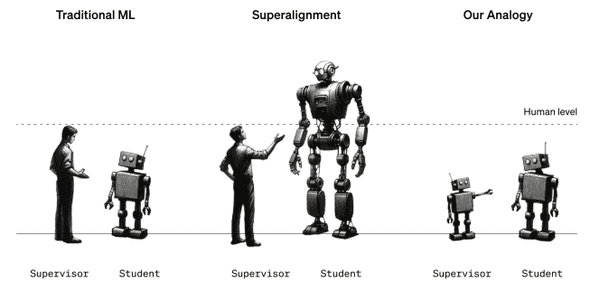
When naively fine-tuned with labels from weaker models, GPT-4 consistently outperforms these models, a phenomenon the authors term weak-to-strong generalization. However, this naive fine-tuning approach falls significantly short of the performance achieved through fine-tuning with ground truth labels. This gap can be reduced by incorporating an auxiliary confidence loss.
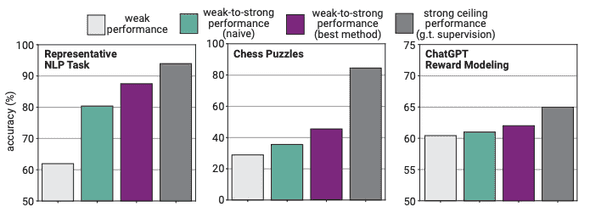
While these findings offer intriguing insights into superalignment, they are also preliminary and come with limitations. For instance, GPT-4’s pretraining data includes human supervision, potentially making it easier to elicit strong capabilities from the model. Super-human intelligence, not being trained on similar data, may not align as readily as GPT-4.
Concluding Remarks
As we look back on the advancements in deep learning in 2023, it’s clear that the field continues to evolve at a rapid pace. From the exploration of Vision Transformers and their artifacts to the development of superalignment for super-human AIs, the year was filled with groundbreaking research and applications. As we move forward, it’s exciting to think about what 2024 will bring. Until next time!
The images in this post are taken from the papers unless the original source is specified.
![[object Object]](/static/2d0f4e01d6e61412b3e92139e5695299/e9fba/profile-pic.png)
Written by Shion Honda. If you like this, please share!







